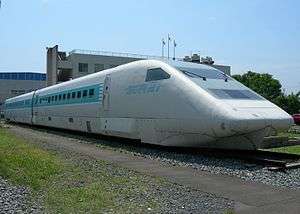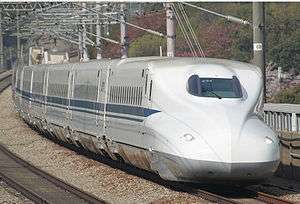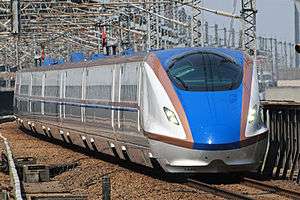STAR21
| Class 952/953 "STAR21" | |
|---|---|
 Preserved cars 953-5 and 953-1 at Sendai Shinkansen Depot, July 2009 | |
| In service | 1992–1998 |
| Manufacturer | Hitachi, Kawasaki Heavy Industries, Nippon Sharyo |
| Constructed | 1992 |
| Scrapped | 1998 |
| Number built | 9 vehicles |
| Number in service | None |
| Number preserved | 3 vehicles |
| Number scrapped | 6 vehicles |
| Formation | 9 cars |
| Fleet numbers | S5 |
| Operator(s) | JR East |
| Line(s) served | Tohoku Shinkansen, Joetsu Shinkansen |
| Specifications | |
| Car body construction | Aluminium alloy |
| Width | 3,100 mm (10 ft 2 in) |
| Maximum speed | 350 km/h (217 mph) (nominal) |
| Traction system | Variable frequency (GTO) |
| Electric system(s) | 25 kV AC, 50 Hz |
| Current collection method | Overhead catenary |
| Track gauge | 1,435 mm (4 ft 8 1⁄2 in) |
"STAR21" was the name given to the Class 952/953 (952・953形) 9-car experimental Shinkansen train developed in 1992 by the East Japan Railway Company (JR East) in Japan to test technology to be incorporated in next-generation shinkansen trains operating at speeds of 350 km/h (217 mph) or higher.[1] The name was an acronym for "Superior Train for the Advanced Railway toward the 21st Century".[2]
Design
The train consisted of nine cars arranged in two distinct "halves", with the Class 952 half-set consisting of four separate vehicles, and the Class 953 half-set consisting of five articulated vehicles using shared bogies.[2][3]
Three different construction methods were used for the vehicle bodies. Cars 1 to 3 used welded hollow aluminium extrusions, cars 4 to 5 used brazed aluminium honeycomb panels, and cars 6 to 9 used an aircraft-style Duralumin fuselage construction.[1]
The front-end design of the two driving vehicles (952-1 and 953-5) were slightly different, although both used a wedge-shaped profile with little lateral taper.[3]
The external livery was light green for the Class 952 cars (including half of car 953-1), "snow" grey for cars 953-1 to 953-3, and beige for cars 953-3 to 953-5, with a light blue window band throughout the length of the train.[2]
Internally, cars were fitted with passengers seats, arranged 2+2 abreast for standard class cars, and 2+1 abreast for the Green car (952-4).[2] Five different types of lightweight seating design were tested.[3]
Formation
The set, designated S5, was initially formed as follows with some cars unpowered.[4][5]
| Car No. | 1 | 2 | 3 | 4 | 5 | 6 | 7 | 8 | 9 |
|---|---|---|---|---|---|---|---|---|---|
| Designation | Tc | M | M' | Ts | T | M | M' | M | M'c |
| Numbering | 952-1 | 952-2 | 952-3 | 952-4 | 953-1 | 953-2 | 953-3 | 953-4 | 953-5 |
| Seating capacity | 56 | 63 | 72 | 34 | 56 | 48 | 48 | 48 | 46 |
| Weight (t) | 30.0 | 29.9 | 33.2 | 25.5 | 19.4 | 20.7 | 21.4 | 20.4 | 27.0 |
| Vehicle length (mm) | 26,250 | 25,000 | 25,000 | 25,000 | 22,250 | 18,500 | 18,500 | 18,500 | 25,500 |
Cars 1 to 3 were built by Nippon Sharyo, cars 4 to 5 were built by Hitachi, and cars 6 to 8 were built by Kawasaki Heavy Industries.[4]
Cars 3 and 7 were fitted with pantographs.[1]
History

The train was delivered in March 1992,[3] and unveiled to the press on 2 April.[6]
On 30 October 1992, the train recorded a Japanese national speed record of 353.0 km/h (219.3 mph) on the Jōetsu Shinkansen between Urasa and Niigata, surpassing the record previously set by JR West's "WIN350" experimental train in August of the same year. On 1 November 1992, the record was raised to 358.0 km/h (222.5 mph) between Tsubame-Sanjō and Niigata.[6]
In 1993, the train was modified with the addition of motors to all axles, increasing its overall rating to 4,620 kW (6,200 hp).[3]
On 13 December 1993, the train reached 400 km/h (248.5 mph), and on 21 December recorded a Japanese national speed record of 425.0 km/h (264.1 mph) on the Jōetsu Shinkansen between Tsubame-Sanjō and Niigata. This record stood until it was broken by JR Central's "300X" experimental train in July 1996.[6]
The STAR21 trainset was officially withdrawn on 17 February 1998.[1][4]
Preservation
End car 952-1 is preserved outdoors at the RTRI large-scale wind tunnel test facility in Maibara, Shiga, first displayed to the public on 10 October 1998.[6] Cars 953-1 and 953-5 are preserved at Sendai Shinkansen Depot.[7] A DT9035B bogie from the train was donated in June 1998 by Sumitomo Metal Industries to the Nara National College of Technology in Nara, where it is kept on display.[8]
- Car 952-1 preserved at Maibara, July 2006
 Car 953-1 preserved at Sendai Shinkansen Depot, August 2002
Car 953-1 preserved at Sendai Shinkansen Depot, August 2002- Sumitomo DT9035B bogie preserved at Nara National College of Technology, June 2012
References
- 1 2 3 4 プロトタイプの世界 - Prototype World. Japan: Kōtsū Shimbunsha. December 2005. pp. 52–55. OCLC 170056962.
- 1 2 3 4 日本と世界の鉄道カタログ [Japan and World Railway Catalogue]. Japan: Seibido Publishing. July 1992. pp. 36–39. ISBN 4-415-03262-1.
- 1 2 3 4 5 Semmens, Peter (1997). High Speed in Japan: Shinkansen - The World's Busiest High-speed Railway. Sheffield, UK: Platform 5 Publishing. ISBN 1-872524-88-5.
- 1 2 3 新幹線電車データブック2011 [Shinkansen Databook 2011]. Japan: JRR. March 2011. p. 95. ISBN 978-4-330-19811-8.
- ↑ JR全車輛ハンドブック'93 [JR Rolling Stock Handbook 1993]. Japan: Neko Publishing. 1993.
- 1 2 3 4 Yamanouchi, Shūichirō (2002). 東北・上越新幹線 [Tōhoku & Jōetsu Shinkansen]. Tokyo, Japan: JTB Can Books. ISBN 4-533-04513-8.
- ↑ 鉄道のテクノロジーVol1:新幹線 [Railway Technology Vol.1: Shinkansen]. Japan: Sanei Mook. April 2009. p. 122. ISBN 978-4-7796-0534-5.
- ↑ Kobatake, Koji (1998). 日本最速新幹線の台車 [Japan's fastest shinkansen bogie]. 1998 Topics (in Japanese). Nara, Japan: Nara National College of Technology. Retrieved 2 June 2012.
Further reading
| Wikimedia Commons has media related to Class 952/953 "STAR21". |
- Nakamura, Tatsuji (June 1992). "952・953形新幹線電車" [Class 952/953 Shinkansen EMU]. Japan Railfan Magazine. Vol. 32 no. 374. Japan: Kōyūsha. pp. 11–17.

